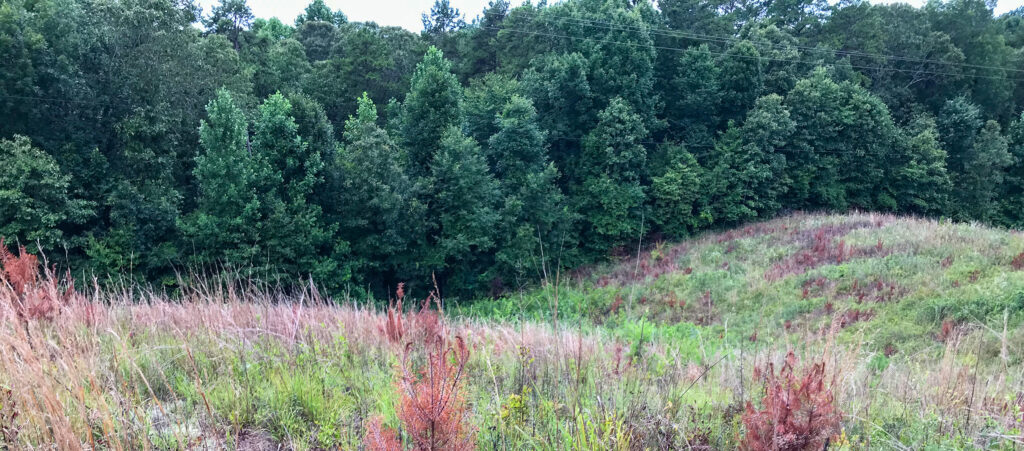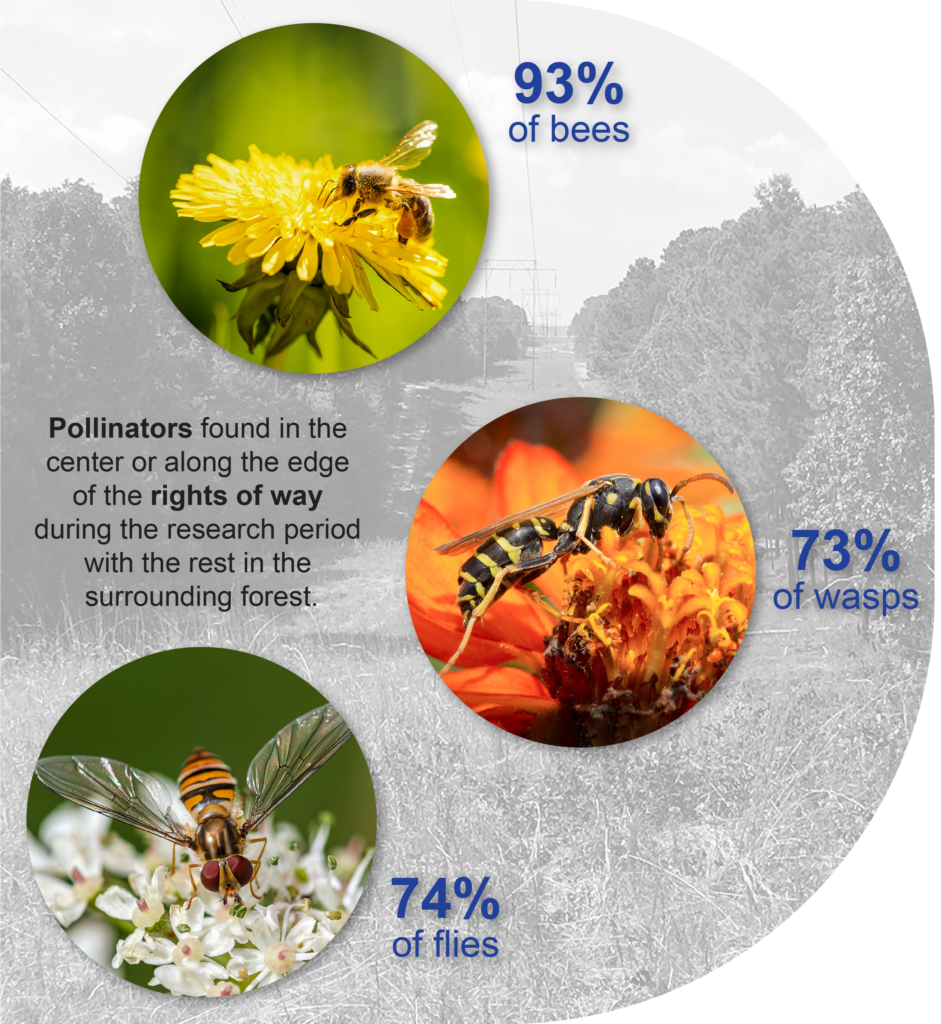How rights-of-way in the southeastern U.S. can benefit pollinating insects
There’s nothing ambiguous about the mission of electric company vegetation managers. Above all, their job is to ensure that the growth of trees, bushes, and other vegetation doesn’t negatively impact the reliable production and delivery of electricity.
In the case of high-voltage transmission lines, the Federal Energy Regulatory Commission (FERC) approves reliability standards that, among other things, specifies maintaining a certain distance between vegetation and the lines themselves. As a result, utilities develop and implement a tree trimming and vegetation management strategy to keep electricity flowing reliably.
Though reliability will always remain the top priority for vegetation managers, there is a growing awareness that there are opportunities to simultaneously bolster reliability while also benefitting biodiversity and, more specifically, pollinators like birds, butterflies, bees, and other insects. Researchers have found that pollinator populations are in decline because of habitat loss, climate change, invasive species, and the use of pesticides. This is a societal challenge because about one-third of all the food we eat and thousands of medicinal plants depend on healthy pollinator populations.
The Benefits of Integrated Vegetation Management (IVM) and Rights-of-Way (ROW)
Many utilities and landowners acknowledge the potential to manage vegetation in ways that both ensure reliable supplies of electricity and benefit pollinators. Electric companies use integrated vegetation management (IVM) to promote low-growing vegetation that doesn’t risk damaging grid infrastructure, like transmission lines, or potentially cause power outages, wildfires, or soil erosion.
EPRI’s Transmission & Distribution (T&D): Environmental Issues Program conducts extensive research into the environmental issues related to the design, construction, operation, and maintenance of T&D infrastructure. This has included reports and research into the potential pollinator benefits of transmission line rights-of-way (ROW) in Arizona, a five-year project with American Electric Power (AEP) highlighting the value of installing prairie habitat for bees, butterflies, and birds, and video about the biodiversity value of rights-of-way in the Southeast U.S.
The opportunity to support pollinator habitat in rights-of-way for high-voltage transmission lines largely depends on how much land they cover. A widely cited estimate calculates that approximately nine million real estate acres are occupied by electric power transmission lines and another 12 million acres occupied by pipelines, meaning there is a total of 21 million real estate acres potentially available for establishing and maintaining habitat. While there is an opportunity to utilize rights-of-way to bolster the populations of flowers and vegetation pollinators depend on without negatively impacting reliability, more research is needed. Little is known, for example, about whether southeastern U.S. rights-of-way have the potential to provide pollinator habitat and what impact integrated vegetation management can have in unlocking that potential.
A Southeastern Focus
Between 2018 and 2021, EPRI collaborated with Southern Company to investigate the potential of right-of-way integrated vegetation management practices to support pollinators and pollinator habitat. Plant and pollinator data collected over a five-year study highlights the value of implementing and selecting IVM practices that can protect and preserve pollinators.
The transmission lines and rights-of-way that Southern Company manages provided a potential opportunity to benefit pollinators. “One motivation for this study was to better understand the importance of rights-of-way in the southeast to pollinating insects. The second was to understand the impacts of integrated vegetation management in terms of herbicide treatments,” said Joe Drumm, natural resources manager at Southern Company. “Our role in the environmental department is not to restrict or tell the vegetation management professionals what to do or not do. But we do want to understand the impact of different management regimes to ultimately inform the best decisions.”
Together with Southern Company subsidiary Alabama Power and Auburn University, EPRI selected four rights-of-way in central Alabama to study. Each of the test sites were a minimum of 1000 meters long and just over 45 meters wide.
To compare the impact of various integrated vegetation management practices on both plants and pollinator insects like bees, wasps, and flies, each of the four plots was divided into three sections. Researchers first established a baseline of the vegetation cover in each of the plots by quantifying the grass, forbs, woody vegetation like brambles and pine trees, and bare ground present when the project began in 2018. Additionally, researchers pinpointed all the flowering plants in each of the test plots and measured their floral blooms to gauge how the frequency and density of the blooms changed over time in response to tested integrated vegetation management practices.
Researchers also established a baseline of pollinating insect populations by collecting information about bees, flies, and wasps in each of the rights-of-way research sections as well as in adjacent forested areas slightly removed from the rights-of-way. After the initial data collection phase, three different herbicides were applied in each of the research areas using either ground or backpack sprayers. The three herbicides used were a high-volume, broad-spectrum herbicide (T1); a low-volume broad-spectrum herbicide (T2); and a low-volume, grass-friendly herbicide (T3). Over the course of 2019, 2020, and 2021, researchers collected vegetation and insect pollinator data monthly during the summer and fall flowering seasons to understand any potential treatment differences on the right-of-way vegetation and pollinator communities.
Lesson Learned: Rights-of-Way Can Benefit Pollinators
The main takeaway of the research was clear: rights-of-way provide habitat that uniquely supports insect pollinators.
“One of the really exciting outcomes of this research was we found a much higher abundance of bees, wasps, and some groups of flies on the rights-of-way compared to off the rights-of-way,” said Dr. Ashley Bennett, an environmental research scientist at EPRI who spearheaded the project. “This suggests that the integrated vegetation management practices Southern Company was using, regardless of the treatment, was providing habitat and resources for those pollinating insects on the right-of-way.”
It is not entirely surprising that rights-of-way offer superior habitat for insect pollinators than the surrounding forestland during the summer and fall. Pollinating insects need flowers for pollen and nectar. In forests, most trees typically flower in the spring. Having floral resources available in the forest in spring and later in the season, having flowers blooming in the rights-of-way can be particularly beneficial for pollinators. “It’s nice to have a forest with early season spring resources adjacent to the right-of-way, where we typically don’t have a lot of flowers blooming early in the season,” Bennett said. “But once we get into the summer and fall season, the right-of-way has a lot more perennial flowers blooming than the adjacent forest.”
Validating Southern Company’s Approach
The results of the research also confirmed that Southern Company’s existing integrated vegetation management practices support pollinating insects. “It’s gratifying that the research shows that our current integrated vegetation management practices are working,” said Jesalyn McCurry, environmental stewardship manager at Southern Company.
The research also deepened the utility’s understanding about available herbicides it could use in its integrated vegetation management. For example, land treated with the low-volume grass-friendly herbicide (T3) had more forbs and less bare ground than land managed with the other two treatments. Areas treated with that same herbicide, T3, also had greater bloom density, and both treatments 2 and 3 resulted in higher bloom frequencies compared to treatment 1.
While there were differences in the impact on vegetation, it was also clear that no single herbicide treatment was significantly more supportive of pollinating insects. This was helpful in confirming that vegetation managers have several options that can both enhance grid reliability and support pollinator habitat. “We want to ensure they have as many tools as necessary in their toolbox that they can deploy to accomplish their mission,” Drumm said.
While the research has practical value by informing the integrated vegetation management of Southern Company, it is also helpful in demonstrating just how real the utility’s commitment to biodiversity and environmental conservation is. “We are proud of our company’s public commitments to protecting and conserving the environment as we serve our customers,” Drumm said. “Biodiversity-focused research, and implementing the findings, is central to demonstrating this commitment.”
The research is also valuable outside of the southeastern U.S. to showcase to other electric companies the potential benefits of pursuing integrated vegetation management practices that support pollinator habitat. EPRI is currently pursuing research to quantify and explore biodiversity supported on rights-of-way outside of the southeastern U.S., including the midwest, northeast, and western United States.
“One area of research we are currently pursuing is demonstrating the overall biodiversity value of rights-of-ways compared to off right-of-way habitat. We can really start to build an exciting story in different regions of the country about the conservation value of rights-of-way if we are able to document groups of conservation concern such as pollinators, birds, and bats are utilizing right-of-way habitat,” Bennett said. EPRI’s T&D Environmental Issues Program will be initiating new research in 2024 evaluating the conservation potential of rights-of-way compared to other off right-of-way habitats.
EPRI Technical Expert:
Ashley Bennett
For more information, contact techexpert@eprijournal.com.



